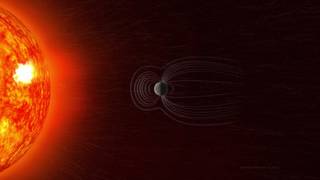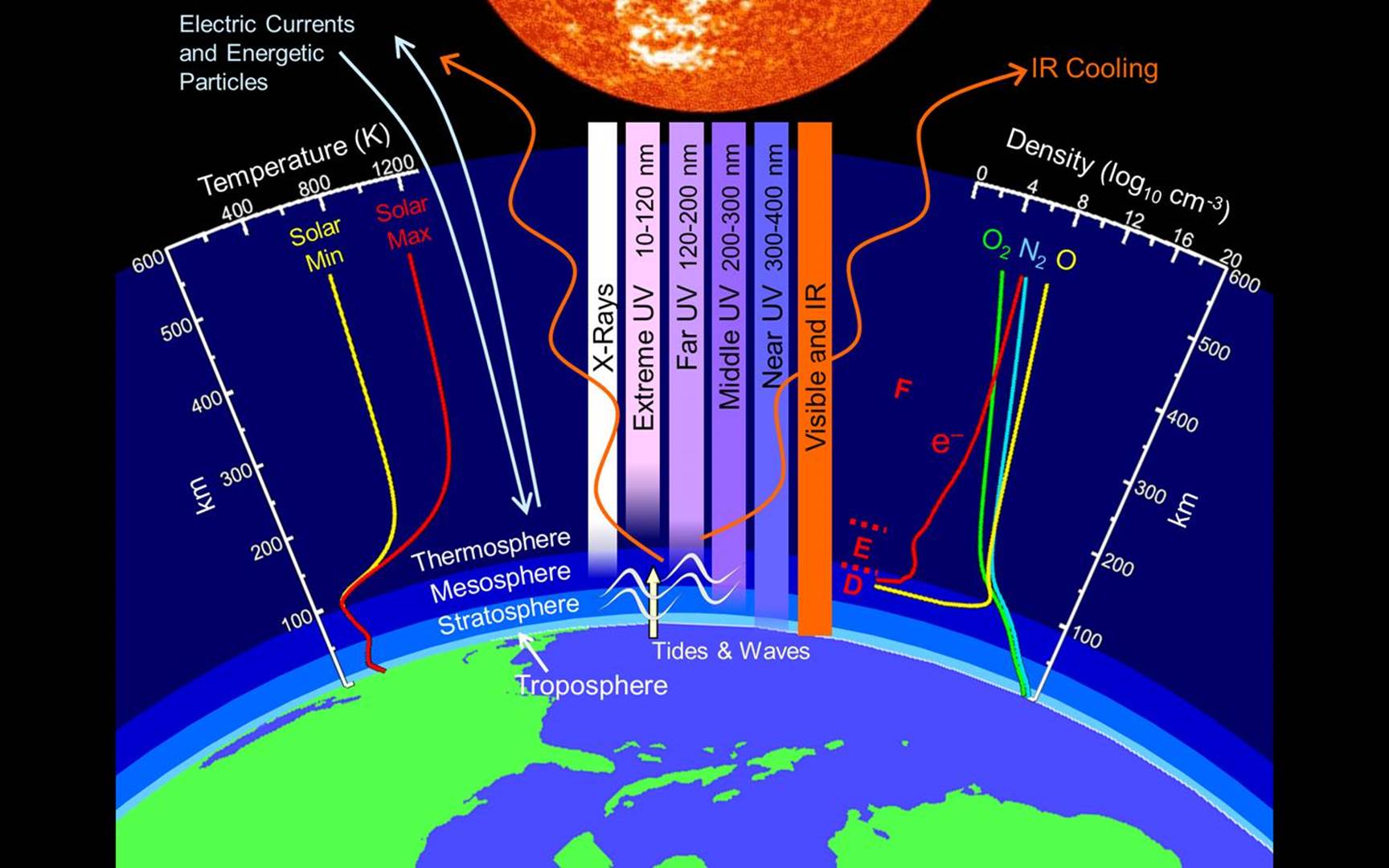Ask NASA Climate | August 3, 2021, 07:07 PDT
Flip Flop: Why Variations in Earth's Magnetic Field Aren't Causing Today's Climate Change
Earth is surrounded by an immense magnetic field, called the magnetosphere. Generated by powerful, dynamic forces at the center of our world, our magnetosphere shields us from erosion of our atmosphere by the solar wind, particle radiation from coronal mass ejections (eruptions of large clouds of energetic, magnetized plasma from the Sun’s corona into space), and from cosmic rays from deep space. Our magnetosphere plays the role of gatekeeper, repelling these forms of energy that are harmful to life, trapping most of it safely away from Earth’s surface. You can learn more about Earth’s magnetosphere here.
Since the forces that generate our magnetic field are constantly changing, the field itself is also in continual flux, its strength waxing and waning over time. This causes the location of Earth’s magnetic north and south poles to gradually shift, and to even completely flip locations every 300,000 years or so. That might be somewhat important if you use a compass, or for certain animals like birds, fish and sea turtles, whose internal compasses use the magnetic field to navigate.
Some people have claimed that variations in Earth’s magnetic field are contributing to current global warming and can cause catastrophic climate change. However, the science doesn’t support that argument. In this blog, we’ll examine a number of proposed hypotheses regarding the effects of changes in Earth’s magnetic field on climate. We’ll also discuss physics-based reasons why changes in the magnetic field can’t impact climate.
Based on data from Swarm, the top image shows the average strength of Earth’s magnetic field at the surface (measured in nanotesla) between January 1 and June 30, 2014. The second image shows changes in that field over the same period. Though the colors in the second image are just as bright as the first, note that the greatest changes were plus or minus 100 nanotesla in a field that reaches 60,000 nanotesla. Credit: European Space Agency/Technical University of Denmark (ESA/DTU Space)
Get NASA's Climate Change News: Subscribe to the Newsletter »
Hypotheses:
1. Shifts in Magnetic Pole Locations
The position of Earth’s magnetic north pole was first precisely located in 1831. Since then, it’s gradually drifted north-northwest by more than 600 miles (1,100 kilometers), and its forward speed has increased from about 10 miles (16 kilometers) per year to about 34 miles (55 kilometers) per year. This gradual shift impacts navigation and must be regularly accounted for. However, there is little scientific evidence of any significant links between Earth’s drifting magnetic poles and climate.
2. Magnetic Pole Reversals
During a pole reversal, Earth’s magnetic north and south poles swap locations. While that may sound like a big deal, pole reversals are common in Earth’s geologic history. Paleomagnetic records tell us Earth’s magnetic poles have reversed 183 times in the last 83 million years, and at least several hundred times in the past 160 million years. The time intervals between reversals have fluctuated widely, but average about 300,000 years, with the last one taking place about 780,000 years ago.
During a pole reversal, the magnetic field weakens, but it doesn’t completely disappear. The magnetosphere, together with Earth’s atmosphere, continue protecting Earth from cosmic rays and charged solar particles, though there may be a small amount of particulate radiation that makes it down to Earth’s surface. The magnetic field becomes jumbled, and multiple magnetic poles can emerge in unexpected places.
No one knows exactly when the next pole reversal may occur, but scientists know they don’t happen overnight: they take place over hundreds to thousands of years.
In the past 200 years, Earth’s magnetic field has weakened about nine percent on a global average. Some people cite this as “evidence” a pole reversal is imminent, but scientists have no reason to believe so. In fact, paleomagnetic studies show the field is about as strong as it’s been in the past 100,000 years, and is twice as intense as its million-year average. While some scientists estimate the field’s strength might completely decay in about 1,300 years, the current weakening could stop at any time.

Plant and animal fossils from the period of the last major pole reversal don’t show any big changes. Deep ocean sediment samples indicate glacial activity was stable. In fact, geologic and fossil records from previous reversals show nothing remarkable, such as doomsday events or major extinctions.
3. Geomagnetic Excursions
Recently, there have been questions and discussion about “geomagnetic excursions:” shorter-lived but significant changes in the magnetic field’s intensity that last from a few centuries to a few tens of thousands of years. During the last major excursion, called the Laschamps event, radiocarbon evidence shows that about 41,500 years ago, the magnetic field weakened significantly and the poles reversed, only to flip back again about 500 years later.
While there is some evidence of regional climate changes during the Laschamps event timeframe, ice cores from Antarctica and Greenland don’t show any major changes. Moreover, when viewed within the context of climate variability during the last ice age, any changes in climate observed at Earth’s surface were subtle.
Bottom line: There’s no evidence that Earth’s climate has been significantly impacted by the last three magnetic field excursions, nor by any excursion event within at least the last 2.8 million years.
Physical Principles
1. Insufficient Energy in Earth’s Upper Atmosphere
Electromagnetic currents exist within Earth’s upper atmosphere. But the energy driving the climate system in the upper atmosphere is, on global average, a minute fraction of the energy that drives the climate system at Earth’s surface. Its magnitude is typically less than one to a few milliwatts per square meter. To put that into context, the energy budget at Earth’s surface is about 250 to 300 watts per square meter. In the long run, the energy that governs Earth’s upper atmosphere is about 100,000 times less than the amount of energy driving the climate system at Earth’s surface. There is simply not enough energy aloft to have an influence on climate down where we live.
2. Air Isn’t Ferrous
Finally, changes and shifts in Earth’s magnetic field polarity don’t impact weather and climate for a fundamental reason: air isn’t ferrous.
Ferrous? Say what?? Bueller? Bueller?
Ferrous means “containing or consisting of iron.” While iron in volcanic ash is transported in the atmosphere, and small quantities of iron and iron compounds generated by human activities are a source of air pollution in some urban areas, iron isn’t a significant component of Earth’s atmosphere. There’s no known physical mechanism capable of connecting weather conditions at Earth’s surface with electromagnetic currents in space.

The plot on the left shows the typical global-average thermal structure of the atmosphere when the flux of solar radiation is at the minimum and maximum values of its 11-year cycle. The plot on the right shows the density of nitrogen (N2), oxygen (O2), and atomic oxygen (O), the three major neutral species in the upper atmosphere, along with the free electron (e−) density, which is equal to the combined density of the various ion species. The F, E, and D regions of the ionosphere are also indicated, as is the troposphere, the atmosphere’s lowest region. Credit: Naval Research Laboratory/J. Emmert
Solar storms and their electromagnetic interactions only impact Earth’s ionosphere, which extends from the lowest edge of the mesosphere (about 31 miles or 50 kilometers above Earth’s surface) to space, around 600 miles (965 kilometers) above the surface. They have no impact on Earth’s troposphere or lower stratosphere, where Earth’s surface weather, and subsequently its climate, originate.
In short, when it comes to climate, variations in Earth’s magnetic field are nothing to get charged up about.
Related Feature
Earth's Magnetosphere: Protecting Our Planet from Harmful Space Energy
